Review: Halberd 1/48 conversion (for Tamiya) XP-72 "Ultrabolt"
The Airplane:
In July 1941, Republic Aviation submitted two new designs, the AP-18 and the AP-19. The AP-18 was an interceptor fighter powered by the Wright R-2160 Tornado engine. The AP-19 was powered by the Pratt & Whitney Wasp X (R-4360). Both engines were under development, with the R-2160 anticipated first. The AP-18 design was ordered on December 1, 1941 as the Republic XP-69.
The R-2160 engine had encountered major issues by 1943, but development of the R-4360 was progressing. Republic told the Air Force that the AP-19 design held more potential and asked to end work on the XP-69. The XP-69 was cancelled on 11 May 1943. Two prototypes of the AP-19 were ordered on 18 June 1943, designated XP-72. Republic felt the XP-72 was superior to the XP-47J, and asked that the second XP-47J prototype be cancelled. The AAF approved the request, and Republic focused on the XP-72.
The XP-72 was called the Super Thunderbolt, or Superbolt, or Ultrabolt, and benefitted from everything Republic had learned with the P-47 series. The airplane was essentially the wings, fuselage, and tail of a bubble-canopy P-47D combined with the close-fitting cowling used on the XP-47J. Numerous internal changes made the XP-72's resemblance to the P-47 an oversimplification of the new design. The 28-cylinder R-4360 drove a fan at the front of the cowling to assist cooling. A small cowl flap was positioned on each side of the cowling. The cowl flaps were automatic but could be manually controlled. Air exiting the cowling was combined with exhaust gases being expelled through ejector stacks and provided a small amount of thrust.
The R-4360 used two-stage supercharging. The first stage was a mechanically-driven, variable-speed, remote supercharger positioned where the turbosupercharger was located on the P-47. To power the remote supercharger, a covered shaft extended from the unit, through the lower cockpit, and connected to the engine via a fluid coupling. The remote supercharger's impeller was around 3 ft (.9 m) in diameter. The second stage was the standard supercharger that was integral with the engine.
A scoop positioned under the fuselage split air into three ducts. The left and right ducts delivered air to oil coolers positioned on the lower sides of the scoop. The center duct fed air to the intake of the remote supercharger and to the intercooler, which was positioned behind the remote supercharger. After being compressed in the supercharger, the air exited via two outlets and passed through the intercooler. After leaving the intercooler, the cooled induction air was split into two ducts and delivered to the R-4360's downdraft intake. Air then passed through the engine's integral supercharger and into the cylinders. Cooling air passed through the intercooler was discharged via an outlet in front of the tailwheel.
Some sources state the XP-72 had strengthened landing gear compared to the P-47, while other sources say it was the same landing gear used on the P-47, though the oleo scissors was positioned on the inboard side of each gear leg. The wings incorporated six .50-cal machine guns with 267 rpg. The gun package could be changed to four 37-mm cannons. A hardpoint under each wing could carry a 150-gallon drop tank or a 1,000 lb bomb. Just like on the P-47, dive recovery flaps were fitted behind the main gear wells.
The XP-72 was roughly the same size and weight as the P-47D but was more aerodynamic and possessed about 50% more power. The XP-72 had a top speed of 490 mph at 25,000 ft. Initial rate of climb was 5,280 fpm, decreasing to 3,550 fpm at 25,000 ft. The service ceiling was 42,000 ft. With 370 gallons of internal fuel and two 150-gallon drop tanks, range was 1,200 miles at 300 mph cruise speed.
The first XP-72 prototype (43-36598) was completed with a Curtiss Electric four-blade propeller 14 ft 2 in diameter, probably the largest propeller fitted to a fighter. The propeller left only 5 in of ground clearance; pilots employed three-point takeoffs and landings to avoid propeller ground strikes. The R-4360-13 engine produced 3,450 hp with the remote supercharger.
The first XP-72 was completed 29 January 1944 and first flew from Republic Field in Farmingdale on 2 February 1944.
The second XP-72 prototype (43-36599) used a 13 ft 6 in diameter, six-blade, contra-rotating Aeroproducts propeller. This propeller gave 9 in of ground clearance; three-point takeoffs and landings were still the standard practice. The second XP-72 was first flown on 26 June 1944, by Republic test pilot and ex-AVG ace Ken Jernstedt.
It is often reported that the second XP-72 was damaged beyond repair because of an emergency landing following an inflight fire. However, Ken Jernstedt stated the incident never happened. According to Jernstedt, he was making a high-performance takeoff from Caldwell, New Jersey when an oil seal on the supercharger failed and caused a massive oil leak. Hot oil sprayed into the cockpit, on Jernstedt's legs, and on the outside of the canopy. When Jernstedt brought the aircraft around for a quick landing, a Vought F4U Corsair suffering from an inflight fire crossed his path. Jernstedt had to veer around the Corsair to land the XP-72, which was damaged in the incident. While the aircraft could have been repaired, the XP-72 program ended soon after.
The Republic XP-72 was noted as exceptionally fast with amazing performance and for having beautiful flying characteristics. Both XP-72 prototypes achieved 490 mph at 25,000 ft.
100 P-72 aircraft were ordered in late 1944. Production P-72s were to be powered by the P&W R-4360-19 engine, which used the Aeroproducts contra-rotating propeller and had an engine-driven, variable-speed, remote supercharger and was expected to provide 3,650 hp at sea level and 3,000 hp at 25,000 ft, giving an estimated top speed of 504 mph at 25,000 ft. Further engine development resulting in 4,000 hp would reportedly enable the P-72 to reach a speed of 540 mph at 25,000 ft. An upgraded wing, similar to that used on the P-47N, was to be used by production P-72s.
As excellent as the P-72 may have been, the aircraft was not needed with the coming introduction of jet aircraft. The order for 100 P-72s was cancelled on 4 January 1945 so Republic could focus on the P-84 Thunderjet. The day the P-72 was cancelled, the AAF ordered 100 P-84s. The two XP-72s survived the war; one airframe, without its engine, was given to a local chapter of the Air Scouts in August 1946. The other airframe was eventually scrapped.
The Kit:
Halberd's conversion kit for the XP-72 is designed for use with the Tamiya 1/48 P-47D “bubbletop” kit, number 61090. It is a drop-fit resin conversion that provides the fuselage, cowling, engine, lower scoop and both propellers as used by the two different prototypes.
Construction:
The XP-72 conversion kit is only slightly more complex than the XP-47H kit, since it includes a separate cowling and a representation of the front section of the R-4360 engine, and the two different propellers.
As with the XP-47H, I built the fuselage first, inserting the completed Tamiya cockpit and the spar assembly; I used Eduard photoetch seat belts in the cockpit. With care, the fuselage was assembled without need of any filler. The centerline seam only needed to be scraped down. There was a need for filler with the lower scoop to fair it into the fuselage.
The wings were assembled according to the Tamiya instructions. My research showed that the oleo scissors on the gear leg was rotated 90 degrees to the inboard side of the leg, and that the main gear door was changed in outline as a result. I made the change for the oleo scissor, and cut the main gear door to the new shape; I glued the piece I cut off to the lower wing to change the shape of the gear well. While it does appear that the gear might have been positioned slightly outboard of where it was on the standard P-47, I decided not to attempt that kind of radical surgery.
Assembly was complete when the wings and horizontal stabilizer and rudder were attached to the Halberd fuselage.
Painting:
Photos show the second prototype was overall unpainted aluminum, with the “Republic stripe” antiglare fore and aft of the cockpit.
The wheel wells and inner gear doors were painted with Mr. Color 352 Yellow Zinc Chromate.
I gave the model an overall coat of Tamiya X-18 “Semi-gloss Black,” then applied an overall coat of Vallejo “Aluminum,” which I misted on. I gave the model 24 hours for the paint to cure, then masked off various panels and painted them with either Vallejo “Dull Aluminum” or “Semi-Matte Aluminum.”
The prop spinner was painted “Aluminum” and the blades “Dull Aluminum” per photos of the original airplane.
Final Finish and Assembly:
I used the kit decals for the second prototype, and an aftermarket P-47 sheet for the national insignia. Photos show there was no stencils, but there was the red “no step” on the inner flap, which I used from the aftermarket sheet.
I then assembled the prop and attached it after I attached the landing gear. I unmasked the canopy and positioned it in the open position.
Overall:
The completed model is a very dramatic-looking Thunderbolt, with the extended cowling and contraprop. It would be interesting to use this conversion set with a Revell P-47N kit to create the “what if” production version.
This is an easy conversion and any modeler willing to commit to careful assembly of the resin parts should have no difficulty creating either prototype of the “Ulta-bolt.”
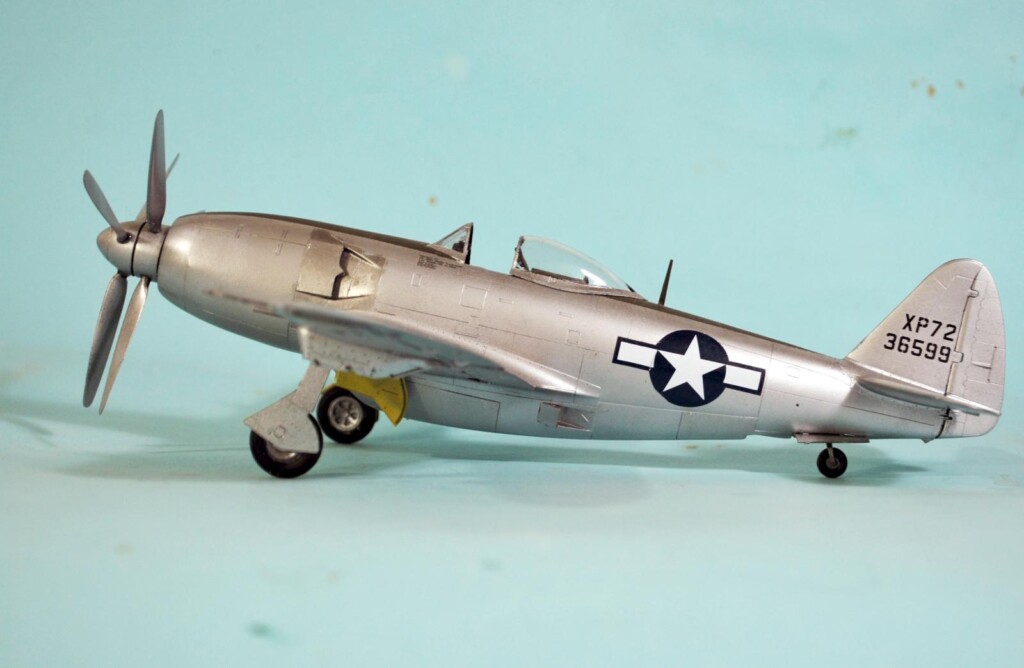
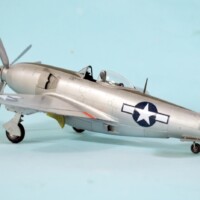
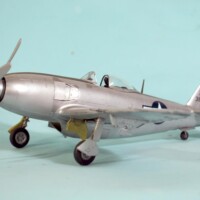

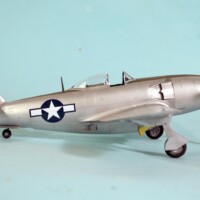
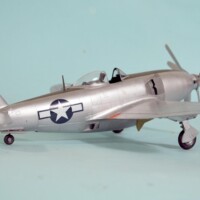
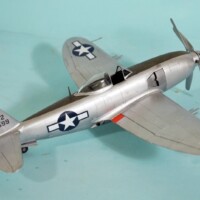
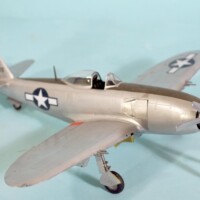
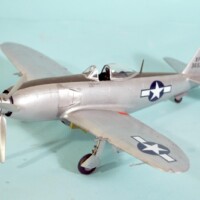
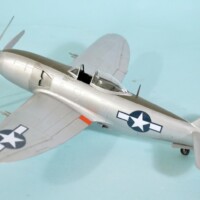
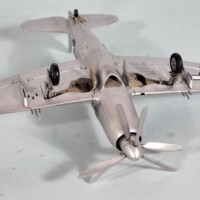
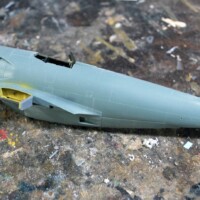
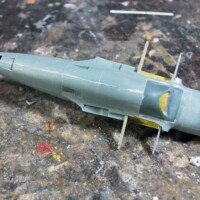
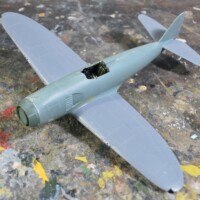
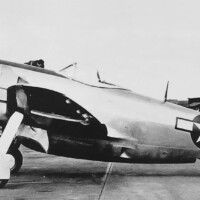
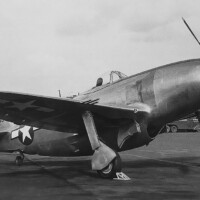
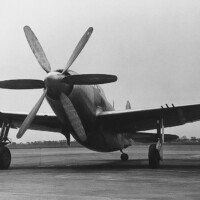
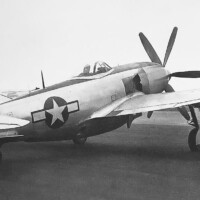

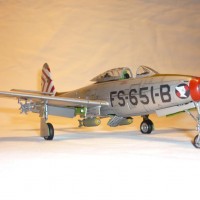
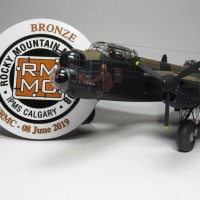
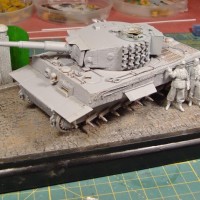
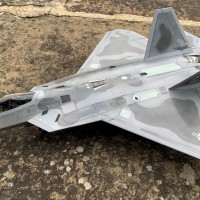
Another awesome result, Tom!
Congratulations!
This really is the epitome of prop driven fighter development. Great result Tom.
Another fine super jug, Tom. That is one mean looking airplane.
With those numbers it truly deserves to be called the Ultrabolt. Perhaps we should be thankful they never survived to be entered in the Cleveland races or later Reno.
And very nice build Tom of a very unique plane.
Wow Tom, @tcinla that looks good. I from the looks of your in progress shots the fit of the fuselage is good and the attachment of the Tamiya parts looks pretty damn good. I am so tempted to get one of these kits, and build it as the American side of the Luft 46 phenomenon.
Excellent looking Super Thunderbolt, Tom @tcinla
Great article as well, always nice to learn about not so well known aircraft.
Great looking build Tom, @tcinla. I was not aware of this plane and am glad you provided such a detailed write-up.
Very convincing build, Tom.
Nice job, Tom!
Very good review, Tom, informative and helpful to anyone contemplating this conversion. I can’t imagine doing a spark plug change on a 28 cylinder engine, you would have to ensure the firing order was correct.
@tcinla - Amazing research/writeup Tom. The twin prop is a definite attention grabber. The various shades of aluminum make for an interesting paint job. Very nice!
Very nice result of an interesting development of the 'Bolt! 😃 I enjoyed this article a lot, Tom @tcinla! 👍
Nice conversion!
Both versions of the XP-72 remind me vaguely of the Raiden.
Another superb build of a very rare aircraft. Some really interesting/weird designs were coming out at that time to push the concept of a prop driven, piston engined airplane during the dawn of jet aviation.
I love the look of this one! Great work!
That is one mean-looking machine! Well done.
Another beautiful model on the theme of the Thunderbolt series. I see for the first time as a model. Beautiful. Aluminum surface excellently processed and informative history.
Interesting write-up and a wonderful built. Thanks for sharing.
Superb result on that beast - looks like another Halberd winner, still waiting for mine. The R-2160 was pretty radical, sounds like a maintenance headache with its 42 cylinders. The R-4360 was a better choice. It would have been interesting to see how the P-72 would have progressed had it gone into production.
Great looking build Tom. The Halberd products are truly some of the best resin kits I've seen. I have the Bf 109 W conversion I hope to get to soon.
Interestingly enough, Lynn Ritger - who is writing the definitive 109 book - found in his research that a 109 floatplane wasn't just a fantasy.
That is very interesting news. I'll have to keep an eye out for this.
Looks like another great conversion by Halberd. Thank you for sharing. I appreciate your history lesson on this airplane, and the previous P-72. I've always had an intrest in both aircraft.
There's nothing to be said about your build except that it's outstanding, as always! Beautiful job, Mr. Cleaver.
Really well done, TC!